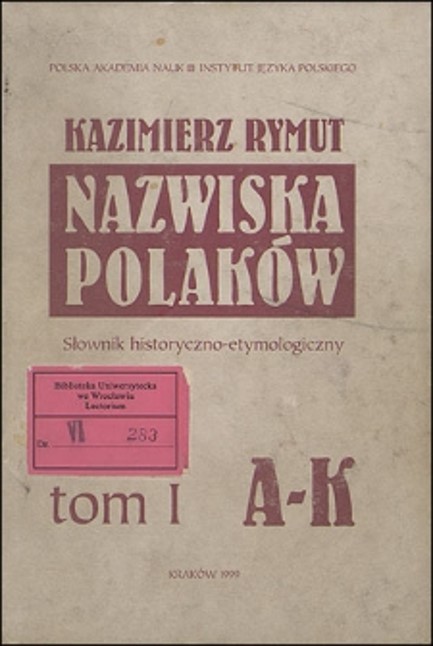The Slownik Nazwisk is Online

If you’ve ever read anything I’ve written on the subject of Polish surnames, you’ve surely seen me refer to the Slownik nazwisk wspolczesnie w Polsce uzywanych, literally “Dictionary of Surnames Currently Used in Poland.” This work, edited by Professor Kazimierz Rymut, is of great value for those deeply interested in Polish names, because it was the first comprehensive compilation of surnames used by citizens of Poland. It was compiled from a 1990 database maintained by a Polish government agency, with data on about 94% of the population of Poland as of that year. It gave a total of all Poles by each name, along with a breakdown of where they lived by province.
So if you want to know what names were borne by Poles, and where those names were most common, this 10-volume set tells you. It runs over 6,000 pages and covers over 800,000 surnames (a huge number of which, however, were either misspelled versions of other names, or extremely rare; so the actual number of “real” names is considerably smaller). This is not exactly light reading — but for someone seriously interested in Polish research, it definitely has its uses.
When I cite data from this work, people often ask “Where can I get hold of this book?” They usually lost interest once I told them it was 10 volumes, in Polish, cost $200, and could only be bought from the publisher in Poland, the Instytut Jezyka Polskiego PAN in Krakow. Still, some organizations, and some intrepid individuals, shelled out the money and bought copies.
Well, this 10-volume set has recently been put online as a searchable database by the Dom Polonii in Pultusk. If you want to consult this source for yourself, go to this page:
http://www.herby.com.pl/indexslo.html
I’ll say more about using this site in a moment. Let me just say right now that you might think those of us who paid $200 for the physical books would be ticked off that the data is now free for anyone who wants it. But the truth is, I, at least, am not at all upset. I’ve had the use of the books for years now, so I got my money’s worth. Besides, as many people have already learned, having access to this data, and making good use of it, are two entirely different matters! I think those of us who had the actual books had an advantage that persists to this day.
Uh, OK, I’ve Got It — What Is It?
When I learned that this searchable database was online, I chuckled as I thought, “Oh, boy, wait till people start trying to use this!” It didn’t take long — soon the Polish mailing lists were full of people saying “How do I use this?” and “What do all these numbers mean?” and “How can I get addresses for the people with this name?”
These are all legitimate questions, and I’m going to talk a little about each of them. I want people to use this site — it means they won’t be bothering me.
But please have just a little bit of patience. Some folks seem convinced all they have to do is type in the right URL, and a little Polish elf will jump out of their computer and tell them everything they need to know. Folks, it’s not going to happen! With this site, as with anything worth doing, you’re going to have to invest a little time and effort. Not a lot, mind you, and the results can be worth it. But magic it ain’t.
How Do I Use This?
You can go directly to the Surname Dictionary page at the address given above; if you want to do that, skip on down below to where it says “Let’s Search for a Surname!” But if you’re patient and aren’t terrified by the thought of navigating through a little Polish, I recommend starting at the home page of the Center that provides this service:
First off, the top of the page reads “Osrodek Dokumentacji Wychodztwa Polskiego przy Domu Polonii w Pultusku” — “Polish Emigration Documentation Center at the Dom Polonii in Pultusk.” This is the official name of the center that’s putting these materials online. It’s headquartered at the Dom Polonii [The Polonia House] in the town of Pultusk, north of Warsaw. This is a splendid complex that includes a wonderful hotel, restaurants, archive, etc. PolishRoots’ Vice President Paul S. Valasek, D.D.S., has visited there and describes it in glowing terms. [For more information on the Dom Polonii itself, see its Website: http://www.dompolonii.pultusk.pl/].
Just below that is a line that reads “Serwis heraldyczno-genealogiczny,” which is, of course, “Heraldic/genealogical service.” (Who says Polish is hard?) Next comes a line for choosing the different pages available:
- Strona glowna — Main Page
- Genealogia, czyli jak szukac — Genealogy, or how to search
- Zasady heraldyczne, czyli z czego sklada sie herb — The Basics of Heraldry, or What a Coat of Arms Consists Of
- Wyszukiwarka herbow — Coat of Arms Search
- Slownik nazwisk — Surname Dictionary
At the moment we are mainly concerned with the last option. When you have a little time, though, you might want to take a look at the others. They’re all in Polish, of course, but if you’re patient and don’t mind wandering about a Website, you just might find a thing or two that will interest you. Those who’d like to know more about Polish heraldry and coats of arms, for instance, certainly ought to take a look at options 3 and 4. At the worst, you lose a few minutes. At the best, you might find Ultimate Truth! (Well, probably not. But you never know!).
From the main page, click on “Slownik nazwisk” and you’ll end up at the same place as if you had gone directly to the first address I gave (http://www.herby.com.pl/herby/indexslo.html). It’s the page where you can search the surname database.
Let’s Search for a Surname!
Look at the box below where it says “Prosze wprowadzic nazwisko.” That’s where you enter the name you’re looking for.
Now, here’s where you need a little instruction. Finding names isn’t as easy as you might think. THIS DATABASE USES PROPER POLISH SPELLING. If the proper spelling of a Polish name includes one of those characters used in Polish but not in English, you must include that character. Thus a search for GORZYNSKI will not find GORZYN~SKI. (The standard spelling of virtually all Polish names ending in -inski and -ynski requires the accented N, not the plain one).
(Oh, and by the way, don’t bother using the tilde: this N~ business we use does not work for Poles at all. Always remember, when you see me or someone else write N~, you have to replace that with the real character, the accented N. L~ must be replaced by the L with crossbar, and so on. These tildes are just a clumsy work-around we use online until software developers finally pull their heads out of their butts and implement full use of Unicode. Only then will we be able to use foreign characters without any of this nonsense.)
Are you out of luck if you don’t know how to use the Polish characters? Not at all! You can, for instance, use the wild card characters * and ?. The symbol * substitutes for any letters and any number of letters; the ? substitutes for any one letter. So a search for GORZY* will bring up all names beginning Gorzy-. Or a search for ZIELI?SKI will bring up Zielin~ski (as well as Zielil~ski and Zieliz*ski, as well as Zielinski without the accent — probably all misspellings made when clerks keyed in the original data).
I personally recommend sidestepping the Polish characters by using the wild cards * and ? — it’s just easier. But if you prefer, you can find the appropriate letter in the rest of the text on that page, highlight it, and paste it into the search box. For the accented n or accented z, however you may have to search around on other pages at the site — I don’t see them on the database search page.
If you know how to use Multilanguage support in Windows to input Polish characters, you can do that, too. That’s what I do. The point is, there’s more than one way to skin this cat!
What Do All These Numbers Mean?
The data that comes up gives the total number of Polish citizens bearing the name in question as of 1990, followed by a breakdown of where they lived by province (under “Rozmieszczenie”). Abbreviations are used for the provinces.
Let me stress: the database from which this material was compiled was NOT comprehensive. It covered about 94% of the population of Poland as of 1990. Complete data was unavailable for some areas; here are the provinces in question and an estimate of how many people were not included:
Bialystok: 66,300
Bielsko-Biala: 99,400
Ciechanow: 30,600
Katowice: 703,000
Krakow: 27,200
Krosno: 254,600
Lomza: 31,200
Nowy Sacz: 325,300
Olsztyn: 60,700
Opole: 220,800
Piotrkow: 303,100
Przemysl: 102,600
Rzeszow: 283,300
Siedlce: 141,500
Sieradz: 46,900
Suwalki: 48,500
Szczecin: 76,800
Walbrzych: 146,900
94% is a lot better than nothing, but do keep in mind that a sizable chunk of the population was not included.
Now, back to the abbreviations for the provinces. To see what they stand for, from the search page, click on the place below the search box that says “Tutaj znajduja sie objasnienia skrotow.” It brings up a little box with the abbreviations. It includes the instruction “Zobacz mape,” which means “See the map.” Clicking on that will bring up a map of Poland with the abbreviations. (Clicking on “Zamknij mape” closes the map.)
In case you have trouble using the box that gives the province abbreviations, you might want to save this list somewhere you can find it easily:
Wa: Warsaw
BP: Biala Podlaska
Bs: Bialystok
BB: Bielsko-Biala
By: Bydgoszcz
Ch: Chelm
Ci: Ciechanow
Cz: Czestochowa
El: Elblag
Gd: Gdansk
Go: Gorzow Wielkopolski
JG: Jelenia Gora
Kl: Kalisz
Ka: Katowice
Ki: Kielce
Kn: Konin
Ko: Koszalin
Kr: Krakow
Ks: Krosno
Lg: Legnica
Ls: Leszno
Lu: Lublin
L~o: Lomza
L~d: Lodz
NS: Nowy Sacz
Ol: Olsztyn
Op: Opole
Os: Ostroleka
Pl: Pila
Pt: Piotrkow Trybunalski
Pl~: Plock
Po: Poznan
Pr: Przemysl
Ra: Radom
Rz: Rzeszow
Sd: Siedlce
Sr: Sieradz
Sk: Skierniewice
Sl~: Slupsk
Su: Suwalki
Sz: Szczecin
Tb: Tarnobrzeg
Ta: Tarnow
To: Torun
Wb: Walbrzych
Wl~: Wloclawek
Wr: Wroclaw
Za: Zamosc
ZG: Zielona Gora
(In this list I indicated diacriticals in the abbreviations, but didn’t bother with them in the town names. That’s because those are all well-known place names; you should have no trouble finding the correct spellings. It’s best not to clutter text with too many ~’s, so I try to use them only when they’re essential to avoid ambiguity).
Note that in the breakdown by province, the number for Wa, Warsaw, always comes first — unless no one by the particular surname in question lived in Warsaw province. Any province with no citizens by the name in question is simply omitted.
Note also that except for Wa, Warsaw, the abbreviations are in alphabetical order as figured by the NAMES OF THE TOWNS: Lu, Lublin, should come before L~o, L~omz*a, because plain L precedes L~. In turn, L~o, L~omz*a, should come before L~d, L~o~dz~, because plain o precedes o~. Similarly, Tb, Tarnobrzeg, should come before Ta, Tarno~w (again, plain o before o~).
Often you can ignore the diacritical marks, but they are crucial in distinguishing Pl, Pil~a, from Pl~, Pl~ock. The same is also true of L~omz*a and L~o~dz~, as I just indicated.
A Sample Name: Jaworski
So, let’s say you key in JAWORSKI, and you click on “Szukaj,” Search. You get this:
Jaworski: 44104. Wa:4814, BP:217, Bs:171, BB:826, By:1276, Ch:290, Ci:699, Cz:622, El:767, Gd:1220, Go:652, JG:917, Kl:548, Ka:2709, Ki:1847, Kn:818, Ko:634, Kr:1232, Ks:278, Lg:737, Ls:198, Lu:1228, L~o:71, L~d:1543, NS:228, Ol:779, Op:697, Os:479, Pl:707, Pt:336, Pl~:839, Po:1090, Pr:138, Ra:2267, Rz:400, Sd:818, Sr:611, Sk:748, Sl~:461, Su:173, Sz:1196, Tb:838, Ta:482, To:1587, Wb:832, Wl~:853, Wr:1867, Za:470, ZG:894
This means there were a total of 44,104 Polish citizens named Jaworski as of 1990 (but since 6% of the population was not included, there were surely more). The data after that is a breakdown of where those Jaworskis lived by province. What more is there to say?
Well, from my experience, there are a few comments in order. For one thing, you may ask — you SHOULD ask — what do the numbers mean, and where did they come from?
They indicate the number of Polish citizens who bore that particular surname as of 1990, according to the database maintained by the PESEL Government Information Center. PESEL is a Polish government agency that assigns every citizen an identification number — in practical terms, it’s a lot like the Social Security number for U. S. citizens. I know every citizen in permanent residence in Poland must get a PESEL number, but I’m not sure at what age. Thus I’m not positive the numbers include children. (If anyone can enlighten me on this, I’d welcome the information!). But it does include virtually all adults.
OK, so does this mean 4,814 Poles named Jaworski lived in Warsaw? NO!!!! It means that many Jaworskis lived in the PROVINCE of Warsaw. People often miss this point. The figures for provinces include all the towns and villages in that province, not just the main city which served as its administrative center. We have no access to data on who lived in what town or village — just a total for the province in question.
Also, the provinces given were the ones in force when the data was collected in 1990 — the 49 provinces that existed under the setup from 1975 to 1998. Beginning in 1999, all that changed. If you want to figure out how those provinces correspond to the current ones, you need to visit one of the sites online that compare them. Here are two good ones:
http://www.polishroots.com/geo_maps.htm
http://www.rootsweb.com/~polwgw/49provs.html
Another point: do the numbers for Jaworski include Jaworska? Yes, they do. For surnames ending in -ski/-ska, -cki/-cka, and -zki/-zka, you can safely assume that the figure for the standard masculine form includes the feminine form as well. Thus Grabowski includes Grabowska, Zawadzki includes Zawadzka, Nowacki includes Nowacka, and so on.
(But I think they dropped the ball on some of the less common adjectival names, such as those ending in -y and -a. For instance, they list Gumienna borne by 756 Poles, and Gumienny by 865. It seems to me they should have combined them into one entry, since Gumienna is just the feminine form of Gumienny. With names ending in -y and -a, therefore, keep your eyes open!)
How Can I Get Addresses?
OK, so now you know what you’ve got. Now the big question: how do you get addresses?
The short answer is, you don’t. The long answer is, you get them the same way you would have if this database had never been put online: by research. Polish privacy laws do a pretty good job of keeping names and addresses, well, private.
In most cases, the question doesn’t arise anyway. One of the things you quickly learn from looking at this data is that the vast majority of Polish surnames are not concentrated in any one place. Getting this data usually doesn’t tell you a thing about where your family came from. Surnames developed centuries ago, and with all that’s happened since then, there’s been plenty of time for people to move around. Even surnames that clearly refer to a specific, unique place name usually turn out to be diffused over much of the country.
And besides, if your name is Jaworski and you think your ancestors came from Warsaw, what good does it do you? You’ve got 4,814 Jaworskis in Warsaw province as of 1990. Even if you had their addresses, are you going to write them all? I don’t think so.
Still, having said all this, I must admit sometimes this data DOES indicate a concentration in one area. In such a case it would be great to have some way of getting an address. The hard way — the way you’ll usually have to do it — is to dig and dig till you trace your ancestors back to a specific area, then try to make contact with a priest or other person in that area who’ll help you get addresses.
Is there ever a short cut? Sometimes. If you find a name is highly concentrated in one area, or you know the exact area they came from, you have a better shot at getting addresses than if you just say, “Duh, my ancestors came from Poland.” One source that might be worth a look was mentioned in the July 2000 issue of the _Polish-American Journal_. In that issue the PAJ Answerman suggested one can find individuals or families “by contacting the one office in Poland that has on file the addresses of all people currently living in Poland: Centralne Biuro Adresowe, ul. Kazimierzowska 60, 02-543 Warsaw, POLAND.”
Now I have no idea whether this works or not, and it’s of no help if a name is scattered all over the country. But in instances where a name is highly concentrated in one area, I like to pass this info along. If this Central Address Office does provide you with addresses for folks with your ancestral name in your ancestral area, chances are decent those addresses belong to relatives. It’s worth a try.
Also possibly worth a try is the Polish telephone directory online at this site:
http://tel.portal.pl/asp/szukaj_a.asp
The problem with this is, you have to specify a surname and a location. So it’s not much good for fishing around if you have just a name or a place, but not both. Please notice, that this site also demands correct spellings with Polish letters. And it won’t let you use wildcards.
So we’re back to how you input Polish letters — and that’s a whole other subject in itself! I can’t tackle that in this issue. Besides, I already discussed it a previous issue of _Gen Dobry!_, Volume II, number 6, “Why Can’t I Key In Polish Letters?” If you want to read it go here: http://polishroots.org/gendobry/GenDobry_vol2_no6.htm.
Conclusion
To sum up, it’s good news that this data is now available online, but you should temper your enthusiasm: you may find it’s not as easy to use as you’d think. And even if you find what you’re looking for, it may not tell you what you hoped it would.
A verion of this article was previously published by Gen Dobry!, Vol. III, No. 8, 31 August 2002. PolishRoots™: http://PolishRoots.org/.


